Szabla
Szabla (Polish pronunciation: [ˈʂabla]; Polish plural: szable) is a one-edged sabre-like mêlée weapon with a curved blade and, in most cases, a two-bladed tip called a feather (pióro). Adapted from Hungarian and Tatar models, initially used by light cavalry, with time it also evolved into a variety of arms used for martial and ceremonial purposes, but also to settle affairs of love, honor, or politics.[1] Until the 19th century, it also served as one of the symbols of the nobility and aristocracy (szlachta) in the Polish-Lithuanian Commonwealth, who considered it to be one of the most important pieces of men's traditional attire.
Etymology
The Polish word szabla "sword, saber" is possibly derived from Hungarian szablya "saber", literally "tool to cut with", from szabni "to cut."[2]
History

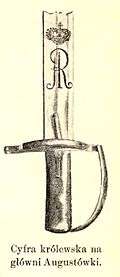
Various types of sabre-like arms were first brought to Central & Eastern Europe by nomadic tribes as early as the 7th century.
This continued in Kievan Rus, the Golden Horde, Byzantium and Hungary until the 14th and 15th centuries, when the curved sword was adopted in Western European warfare, including Bohemia and Germany. Initially the sabres were used in Hungary and Kievan Rus. These are the oldest sabres known to archaeology.[3]
Although by early 16th century swords of this type were used both in Hungary, where they were the traditional cavalry sword, in the Polish-Lithuanian Commonwealth most of them were spoils, not normally used and only issued to peasants in an emergency. As such, they were considered plebeian weapons unworthy of the nobility. The higher classes and the knights at that time still preferred straight-bladed swords, much like their western European counterparts. However, with time the advent of firearms and artillery, as well as constant pressure from the Ottoman Empire and the Tatars, who used light cavalry in large numbers, prompted a movement away from the old paradigm of heavily armored medieval men-at-arms—a movement that also manifested itself in a changing preference for sword blade types. It was in the 15th century that curved swords were adopted in Polish–Lithuanian Commonwealth and Hungary, both countries having the most extensive contacts (largely hostile) with the Mongols, Turks and Tatars.
The following century, after the election of Transylvanian-Hungarian noble Stefan Batory as king of Poland, the entire Polish army was reformed to suit the new needs. The series of Polish-Lithuanian Union, as well as extensive contacts with Hungary and Transylvania, made the sabre one of the basic arms used by the nobility, formerly using the swords. With time the sabre evolved in the Polish-Lithuanian Commonwealth and gave birth to a variety of sabre-like weapons, fit for various tasks. In the following centuries, the ideas of Sarmatism as well as the Polish fascination with Eastern attire, customs, cuisine and warfare resulted in the szabla becoming an indispensable part of attire of the szlachta, as well as one of the symbols of nobility and its alleged ancient roots.
Construction
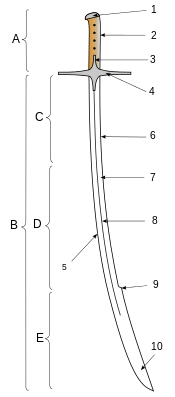
The main feature of a szabla is a curved one-edged blade, often with a yelmen (pióro "feather" in Polish).
As in most swords, Polish sabres were composed of a variety of parts, each bearing a different name (Polish terms in parentheses):
- Hilt (rękojeść) (A)
- Blade (głownia) (B)
- forte (zastawa) (C) - the upper part of the blade, usually used for blocking (hence the Polish name) of strong pushes (hence the French-derived English term); usually it covered roughly the 3rd part of the blade.
- (moc) (D)
- foible (sztych) (E) - the tip of the blade, often double-edged
The forte and foible could be visually separated by two claws on the non-sharp side of the blade, the threshold (próg) and the martle (młotek). Both sides of the blade could be shaped in a variety of ways and were often decorated with ornaments or inscriptions. Other signs featured on the flats include producer's marks and coats of arms.
Elements:
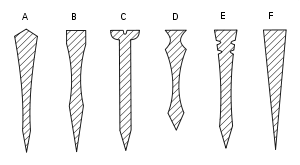
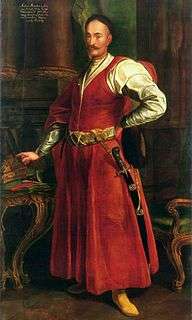
The greatest diversity is found in various types of the hilt, which define the purpose of the sabre. The Polish sabres could usually be divided onto:
- open hilt - a classical sabre with cross-guards
- half-open hilt - with a knuckle-guard bent vertically and not joined to the pommel
- closed hilt - with one or more knuckle-guards forming a guard around bearer's palm
Types
Hungarian-Polish szabla
The first type of szabla, the Hungarian-Polish (węgiersko-polska), was popularized among the szlachta during the reign of the Transylvanian-Hungarian King of Poland Stefan Batory in the late 16th century. It featured a large, open hilt with a cross-shaped cross-guard and a heavy blade, either uncurved at all or curved only slightly. Since the saber provided little to no hand protection, a chain was attached to the cross-guard and the pommel.[4] Since a number of such weapons were made by order of the king himself during his reform of the army and were engraved with his portrait, this kind of sabre is also referred to as batorówka - after Batory's name.
Armenian-style szabla
In the late 17th century the first notable modification of the sabre appeared. Unlike the early "Hungarian-Polish" type, it featured a protected hilt and resembled the curved sabres of the East. It was hence called the Armenian sabre, possibly after Armenian merchants and master swordsmiths who formed a large part of arms makers of the Commonwealth at those times. In fact the Armenian sabre developed into three almost completely distinct types of swords, each used for a different purpose. Their popularity and efficiency made the Polish nobles abandon the broadswords used in Western Europe.
- Czeczuga was a curved sabre with a small cross-guard with an ornamented open hilt and a hood offering partial protection to the hand.
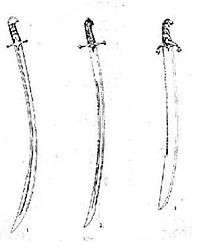 Armenian Versions (right) Czeczuga, (left) Armenian Karabel, (middle) Ordynka.
Armenian Versions (right) Czeczuga, (left) Armenian Karabel, (middle) Ordynka. - Ordynka was a heavier weapon used by the cavalry. It resembled a mixture of all the features of the Czeczuga with a heavier and more durable hilt and blade of the short sword.
- Armenian karabela was the first example of a ceremonial sword used by the szlachta. It had both its blade and cross-guard curved, and had a short grip. It was engraved and decorated with precious stones and ivory. Used throughout the ages, in the 18th century it evolved into a standard karabela, used both as a part of attire and in combat (see below).
Hussar szabla
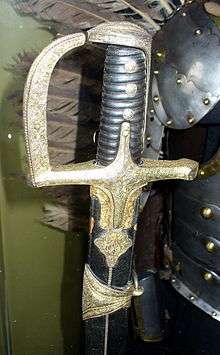
The hussar sabre was perhaps the best-known type of szabla of its times and became a precursor to many other such European weapons. Introduced around 1630, it served as a Polish cavalry mêlée weapon, mostly used by heavy cavalry, or Polish Hussars. Much less curved than its Armenian predecessors, it was ideal for horseback fighting and allowed for much faster and stronger strikes.[4] The heavier, almost fully closed hilt offered both good protection of the hand and much better control over the sabre during a skirmish. Two feather-shaped pieces of metal on both sides of the blade called moustache (wąsy) offered greater durability of the weapon by strengthening its weakest point: the joint between the blade and the hilt. The soldier fighting with such sabre could use it with his thumb extended along the back-strap of the grip for even greater control when 'fencing' either on foot or with other experienced horsemen, or by using the thumb-ring, a small ring of steel or brass at the junction of the grip and the cross-guard through which the thumb is placed, could give forceful downward swinging cuts from the shoulder and elbow with a 'locked' wrist against infantry and less experienced horsemen. This thumb ring also facilitated faster 'recovery' of the weapon for the next cut. A typical hussar szabla was relatively long, with the average blade of 85 centimetres (33 in) in total. The tip of the blade, usually some 15 to 18 centimetres long, was in most cases double-edged. Such sabres were extremely durable yet stable, and were used in combat well into the 19th century.
The Polish and Hungarian szabla's design influenced a number of other designs in other parts of Europe and led to the introduction of the sabre in Western Europe. An example that bears a considerable resemblance is the famous British 1796 pattern Light Cavalry Sabre which was designed by Captain John Gaspard le Marchant after his visits "East" to Central and Eastern Europe and research into these and other nations' cavalry tactics and weapons. Poland had ceased to exist as a separate nation by this time but their other co-nation from previous centuries, Hungary, was still an existing nation, and as this was the source of all things "Hussar", it was the Polish-Hungarian szable of 150 years earlier rather than the oft quoted Indian tulwar that were the main source of inspiration for the first "mainly cutting" sabre in the British Army. This same "1796" sabre was taken up by the King's Hanoverian troops and also by the Prussians under General Gebhard Leberecht von Blücher who attempted to give his name to the weapon, almost universally known as "the 1796 Light Cavalry Sabre" in the rest of Europe. This weapon also found its way into the cavalry of the newly formed United States of America in the War of 1812.
Karabela
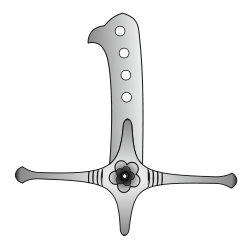
Perhaps one of the most famous types of a Polish sabre was the classical karabela, which entered service around 1670. Most likely the name was coined after the Turkish terms Kara (dark) and bela (curse). The type of the sabre was modelled after the swords of the Turkish footmen formations of Janissaries and Spahis, which used it in close quarters. Much lighter than the hussar szabla, the karabela had an open hilt with the pommel modelled after eagle's head. Such an anatomic grip allowed for easier handling of circular cuts while fighting on foot and for swinging cuts from horseback.
Initially the karabela sabres were used mostly for decoration or as a ceremonial weapon worn on special occasions. Popularized during the reign of King Jan III Sobieski, the sabre became one of the most popular Polish cold steel weapons. Though in theory the type could be subdivided into an ornamented ceremonial type and a simple battle weapon, in reality both were more expensive, and the cheaper designs were often used in combat. Most of the szlachta could afford only one expensive karabela and, in case of a dire need, simply replaced the ebony or ivory scabbard with a leather version and removed some of the precious stones from the hilt in order to convert it into a reliable weapon.
Other types
- Kosciuszkowska, a variant popularized during the Kościuszko Uprising;
- Szabla wz.34 ("model 34 szabla"), a 20th-century variant produced from 1934 in the Second Polish Republic for Polish cavalry; just about 40,000 were made.
Technique
Stance
There are many stances for the Szabla, such as Back-Weighted, Toes Forward, Even-Weighted, and Forward-Weighted.
Back-Weighted is a stance in which the back leg is bent, and put the weight onto. While the front leg is free to move with little weight in the case of an attack by the opponent.[4]
Toes Forward is a stance in which weight is evenly distributed between each leg. The balls of the feet are planted on the ground while the toes are raised.[4]
Even-Weighted is a stance in between Forward-weighted and Back-weighted.[4]
Forward-Weighted is a stance in which most of the weight is on the front leg, allowing the back leg to move freely. This allows the person to lean into or away from the attacker.[4]
Footwear
Proper footwear was also very important when it comes to stance. There are two main types of footwear used in Poland at the time, Polish Hussar Boots and Turkish footwear.[4]
Polish Hussar Boots were used in the 17th century. They came in mostly yellow, gold, or maize coloring. They had a high heel and also allows for the ball of the foot to rest naturally on the ground.[4]
Despite the name, Turkish footwear was common in 17th century Poland. Like the Polish Hussar Boots, these boots had a high heel for attaching spurs, as well as allowing the ball of the foot to rest on the ground.[4]
See also
Bibliography
- W. Kwaśniewicz, Leksykon broni białej i miotającej, Warszawa, Dom wydawniczy Bellona, 2003 ISBN 83-11-09617-1
- W. Kwaśniewicz, Dzieje szabli w Polsce, Warszawa, Dom wydawniczy Bellona, 1999 ISBN 83-11-08894-2
- Andrzej Nadolski "Polska broń. Biała broń", Warszawa 1974
References
- Notes
- ↑ Marsden, Richard (2013). "Polish Saber". HEMA Alliance.
- ↑ Harper, Douglas (2001). "Online Etymology Dictionary".
- ↑ site, sword. "avar sabre". Sword Site. Sword Site. Retrieved 10/07/2016. Check date values in:
|access-date=(help) - 1 2 3 4 5 6 7 8 9 Marsden, Richard (2013). "Polish Saber". HEMA Alliance.
